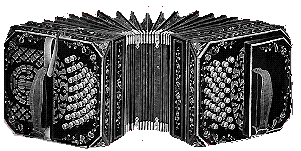

a short history

Download
solo bandoneon MP3 by Olivier Manoury CD
quality (longer)
Listen to solo bandoneon by Olivier Manoury
For thousands of years,mouth organs (cheng, khen, etc.) used in the far east, incorporated pipes coupled to free reeds,but it is only last century that the free reed sonic principle ( metal reeds without pipes) was discovered in Europe. This discovery made possible the advent of a whole series of similar instruments of various shapes and sizes bearing a great variety of names (harmoniums,reed organs, accordions, harmonicas etc.).
The BANDONEON is an offshoot of a family of german button and bellows instruments called KONCERTINAS,invented around 1845. Koncertinas (distinct from those played in the british isles) were small square instruments which had 14 buttons on each side. Later this number increased to more than 70
The first bandoneon was in fact a konzertina made around the year1856 and to which the commercial name of "bandoneon" was given in memory of Einrich Band, who had a music shop in Krefeld (north Germany)
The bandoneon was developed throughout Germany under various sizes and systems. One of these many different models,the "Reinlander"(from the Rein district) was exported to Argentina at the very end of last century,whereas the "Chemnitzer"(from the city of Chemnitz) was brought to USA by Polish and Czech migrants. Germany used to sell a lot of musical instruments to both north and south America,i.e. the harmonicas used in blues, the melodeons used in Cajun music and all kinds of accordions in the brazilan Nordeste, Colombia and so on.
The Bandoneon was very quickly adopted in Buenos Aires and became the symbol of Tango. It was never built there.Most bandoneons were made by the german maker ALFRED ARNOLD from 1911 untill few years after the war.
The argentinian bandoneon is a two voice instrument (each note
being doubled at the superior octave) with 71 buttons. Each button plays a different
note depending on whether the bellows is opened or closed (unproperly called
diatonic). Around 1925, Charles Peguri,an Italian accordion player and repairer
settled in Paris designed a new keyboard where each button produced the same
note regardless of whether the bellows was open or closed (called "chromatic")
which has been widely used in France
For playing Tango, the bandoneon must be tuned without vibrato (the two voices
being precisely an octave apart).
For more information there is a bandoneon discussion group on the net: email
bandoneon@ultr5.vub.ac.be
BANDONEON FAQ
please read thoroughly the FAQ before asking information
For more informations about free reeds history and instruments please visit
Pat Missin wonderful
website
For more informations about bandoneon history and music please visit Christian Mensig 's Bandoneon Page